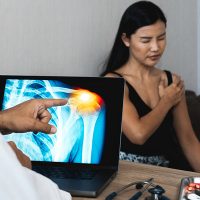Accidents Can Cause Rotator Cuff Injuries

You likely have given little thought to how it is that your arm is able to rotate in so many ways, while only being attached by and at your shoulder. The answer is the anatomy of the shoulder, which is especially designed to provide your arm the movement that it has. But that same anatomy can be very susceptible to injury in an accident.
The Anatomy of the Shoulder
At the end of the bones in your arm, where it meets the shoulder, there is a circular golf-ball sized rounded bone. That rounded bone fits into a cup at the end of your collar bone, which is shaped specifically to take in and accept the shape of the rounded ball.
But just a ball fitting into a socket isn’t enough; those two bones need to stay together firmly enough to do what your arm does on a daily basis, but it also has to provide mobility and flexibility.
It does this through a network of tendons and ligaments that hold everything together. Collectively, this network is called a rotator cuff. The ligaments in your shoulder are similar to those in any joint where bones need to be held together but allow for movement—imagine the anterior cruciate ligament in the knee, for example.
How a Rotator Cuff Gets Injured
Many people aren’t aware of how vulnerable the rotator cuff is in an injury. Any force exerted on a stiffened arm can put force on the rotator cuff, stretching or breaking the ligaments in the rotator cuff.
As an example, imagine you fall to the ground, and you hold out your arm to brace your fall. Your hand hits the ground first, but the force of the ground is transferred up your arm, up to the shoulder pushing the shoulder out of place.
The same holds true if you were to grasp a steering wheel and be hit from behind by another car. The force of the accident would push your torso forward, but your shoulder would remain in place because of your grasp on the steering wheel. This can, and often does, jar the shoulder bones out of place, rupturing the ligaments in the rotator cuff.
Signs and Symptoms
Sometimes, you will have immediate pain in the shoulder area after an accident, but other times, the pain may be slower to manifest. A telltale sign of a rotator cuff injury, is that it will hurt constantly, almost all the time-—not just when you’re using the shoulder or arm, and not just when the shoulder or arm are lifting something or facing resistance.
Other indicators are limitations in the range of movement in your shoulder with pain. The pain can be so bad in more severe cases, that it can affect sleep or the ability to do daily chores, like type, do laundry, or steer a car.
Some rotator cuff injuries will get better with therapy, but in more serious cases, surgery may be needed to repair the shoulder.
If you have sustained a shoulder injury, or any other kind of injury, after an accident, we can help. Contact our Rhode Island injury lawyers at Robert E. Craven & Associates at 401-453-2700 today.
Sources:
my.clevelandclinic.org/health/diseases/8291-rotator-cuff-tear
hopkinsmedicine.org/health/conditions-and-diseases/rotator-cuff-injury
